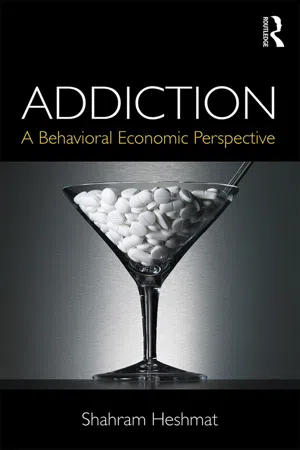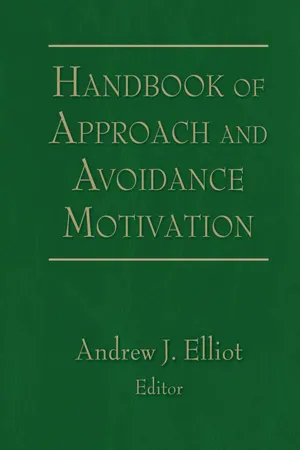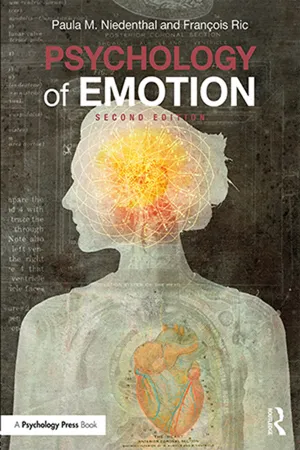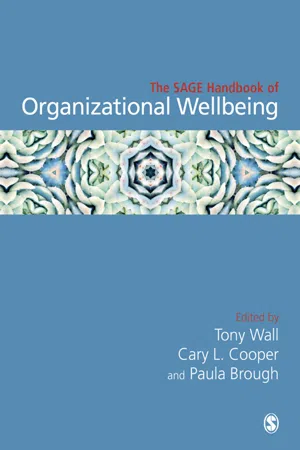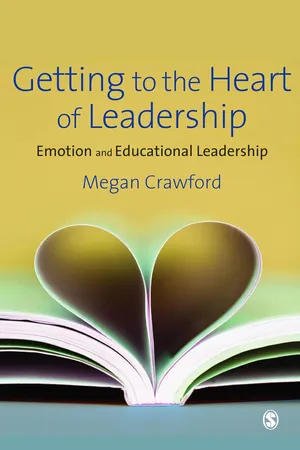Business
Functions of Emotions
The functions of emotions in business include providing valuable information about employees' and customers' needs, influencing decision-making and behavior, and shaping organizational culture. Emotions can also drive motivation, creativity, and innovation, as well as impact customer satisfaction and loyalty. Understanding and managing emotions in the business context is crucial for fostering a positive work environment and achieving business success.
Written by Perlego with AI-assistance
Related key terms
8 Key excerpts on "Functions of Emotions"
- eBook - ePub
Addiction
A Behavioral Economic Perspective
- Shahram Heshmat(Author)
- 2015(Publication Date)
- Routledge(Publisher)
4 Definition and Functions of Emotions DOI: 10.4324/9781315774541-4Introduction
In the previous chapter, addiction was characterized as a complete absence of control when confronted with an object of desire. This characterization of addiction makes it important for studying the struggle between appetite (reason and desire) and emotion. The question is how emotions matter and how they influence individual actions.Traditionally, emotion is considered harmful to decision making. When we act under the influence of emotions and strong feelings (anger, fear, craving), they may cause us to deviate from plans laid in a cooler moment and act impulsively against our own best judgment. However, many thinkers now suggest that emotions can be very helpful in making decision with little or no conscious deliberation.This chapter provides a brief introduction to some basic concepts and mechanisms of emotions to provide an understanding on the nature and function of emotion. The purpose is to discuss such questions as, what are emotions, and why do we have emotions? What are the rules by which emotion operates? Are emotions beneficial, as essential to our rationality? The focus is on the role of emotions in information processing and decision making.The Importance of Emotion
We organize our lives to maximize the experience of positive emotions and minimize the experience of negative emotions. Emotions determine the quality of our lives and are of interest to everyone. They set our priorities, make our lives meaningful, and communicate our intentions (Ben-Ze’ev, 2000 ). Emotions are motives that direct our attention by selecting what attracts and holds our attention. Without that sense, decision making and actions are derailed. A thorough understanding and exploration of any subject matter requires persistent motivation and curiosity. Without fascination and obsession, much of learning is unlikely to be above and beyond the ordinary.1 - eBook - ePub
- Gesine Lenore Schiewer, Jeanette Altarriba, Bee Chin Ng, Gesine Lenore Schiewer, Jeanette Altarriba, Bee Chin Ng, Gesine Lenore Schiewer, Jeanette Altarriba, Bee Chin Ng(Authors)
- 2023(Publication Date)
- De Gruyter Mouton(Publisher)
Lutgen-Sandvik, and Alberts 2006 : 148). Importantly, language also provides a powerful mechanism to improve how emotions are shaped and experienced, and to positively impact workplace interactions and therefore organizations more broadly.7 References
Anderson, Peter A. & Laura K. Guerrero. 1998. Principles of communication and emotion in social interaction. In Peter A. Anderson & Laura K. Guerrero (eds.), Handbook of communication and emotion: Research, theory, applications, and contexts, 49–96. San Diego: Academic Press. →Anderson, Lynne M. & Christine M. Pearson. 1999. Tit for tat? The spiraling effect of incivility in the workplace. Academy of Management Review 24(3). 452–471. →Ashforth, Blake E. & Ronald H. Humphrey. 1993. Emotional labor in service roles: The influence of identity. Academy of Management Review 18(1). 88–115. a , bAshforth, Blake E. & Ronald H. Humphrey. 1995. Emotion in the workplace: A reappraisal. Human Relations 48(2). 97–125. a , bAshforth, Blake E. & Glen E. Kreiner. 2002. Normalizing emotion in organizations: Making the extraordinary seem ordinary. Human Resource Management Review 12(2). 215–235. →Ashkanasy, Neil M. & Alana D. Dorris. 2017. Emotions in the workplace. Annual Review Organizational Psychology and Organizational Behavior 4(1). 67–90. a , bBarsade, Sigal G. 2002. The ripple effect: Emotional contagion and its influence on group behavior. Administrative Science Quarterly 47(4). 644–675. a , bBass, Bernard. M. 1985. Leadership and performance beyond expectations. New York: Free Press.Boren, Justin P. 2014. The relationships between co-rumination, social support, stress, and burnout among working adults. Management Communication Quarterly 28(1). 3–25. a , b - eBook - ePub
- Andrew J. Elliot, Andrew J. Elliot(Authors)
- 2013(Publication Date)
- Psychology Press(Publisher)
21 Functions of Emotions and Emotion-Related Dysfunction Eric YoungstromDOI: 10.4324/9780203888148-46CONTENTS
- Functionalist Perspective on Emotions
- Emotions as Evolved Capacity: Three Levels of Analysis
- Functions of Emotions
- Specialization
- Rapid Appraisal
- Rapid Response
- Survival Fitness
- Reproductive Fitness and Sexual Selection
- Affiliation
- Competition
- Runaway
- Approach, Avoidance, and Sex
- Social and Interpersonal Functions: Building, Maintaining, and Changing Networks
- Intrapersonal Functions: Sculpting the Self
- Runaway Software: Emotions, Memes, and Culture
- Emotion-Related Dysfunction
- Models of Emotion and Psychopathology
- Conflict as Normative Development
- Too Much of a Good Thing (Statistical Models of Extremity)
- Dysfunction as Transaction: Right Feelings, But at the Wrong Place and Time
- Mutation—Fractures in an Otherwise Good System
- Sneaky Value Added (Subtle or Counterintuitive Adaptive Value)
- Approach and Avoidance Emotional Models of Psychopathology: Behavioral Inhibition System and Behavioral Activation System
- Conclusion
- References
The goal of this chapter is to review the function and dysfunction of emotions within an overarching framework of approach and avoidance. The discussion of emotions will adopt an explicitly functionalist perspective, as described in the first section. The function of emotions and emotion-related dysfunction are addressed in the second and third sections. Whereas most prior evolutionary treatments of the functionality of emotions have concentrated on the survival value of emotions, our discussion also adds the element of reproductive advantage. We will argue that much of the function and dysfunction of emotions in human culture has been affected by sexual selection as well as survival pressures. Finally, and perhaps most provocatively, we explore the idea of memetic replication with regard to emotion. We argue that emotions offer a powerful ally for the propagation of memes, and hopefully will offer some provocative ideas about the plasticity with which both culture and self are developing. - eBook - ePub
- Paula M. Niedenthal, François Ric(Authors)
- 2017(Publication Date)
- Psychology Press(Publisher)
Research shows that people with high emotional intelligence are more successful in a number of domains of life (Mayer, Salovey, & Caruso, 2008). For instance, they are less likely to engage in bullying and violent behavior (Rubin, 1999) and less likely to abuse drugs and alcohol (Brackett, Mayer, & Warner, 2004). They also tend to have more successful relationships, be judged as more interpersonally sensitive (Brackett et al., 2006; Lopes, Salovey, & Straus, 2003), and be better managers in organizational settings than individuals with low emotional intelligence (Rosete, 2007).Disruptions in emotion-processing capacity cause bad outcomes and well-developed emotion skills yield good outcomes. These facts suggest that emotions are, on average, functional. But just how and for whom?Survival Function of Emotion for the Individual
One of the questions we can ask, when considering the function of emotions for the individual, is whether our emotions aid our ability to survive and thrive in the face of challenges and opportunities. As a general principle, although a feeling may be subjectively unpleasant, or although the endocrine or autonomic part of the emotion may be costly to the body, on average, there is a beneficial survival function that emotions serve for most people, most of the time. Next we discuss three ways in which emotions are functional for the individual. In particular, we show how 1) the physiology of emotion supports adaptive action, 2) the feelings of emotion regulate the pursuit of goals, and 3) action tendencies of emotion promote the selective responses to the world that results in a broadening of the individual’s repertoire of cognitive and behavioral responses. The functionality of facial expression for the individual is discussed in detail in Chapter 5 .Physiology
The emotions we experience vary in their degree of physiological arousal (Levenson, 2003). The main system of the body that regulates arousal and other relatively automatic biological processes (e.g., breathing, sweating, digesting) is the autonomic nervous system (ANS), which we also discussed in Chapter 3 . The ANS is composed of two subsystems that typically work in opposition. The sympathetic nervous system (SNS) is excitatory, augmenting activity in ANS-regulated systems (e.g., increase in heart rate). Activity of the SNS becomes dominant during physical or psychological stress, producing arousal to aid in mobilizing the energy needed to respond to the challenge. Due to its excitatory function, the SNS is commonly referred to as the “fight or flight” portion of the ANS. On the other hand, the parasympathetic nervous system - eBook - ePub
- Tony Wall, Cary L Cooper, Paula Brough, Tony Wall, Cary L Cooper, Paula Brough(Authors)
- 2021(Publication Date)
- SAGE Publications Ltd(Publisher)
5 Emotions and Wellbeing at Work: A Multilevel Perspective Ashlea C. Troth, Alannah E. Rafferty, and Peter J. JordanIntroduction
It's business, leave your emotions at the door. The Wolf of Wall StreetInterest in how emotions shape organizational attitudes and behaviors has risen over the last couple of decades among scientists and practitioners (Ashforth and Humphrey, 1995; Barsade and Gibson, 2007; Hochschild, 1983). Appreciation of the critical role of workplace emotions emerged during the 1980s. Prior to this, the idea of emotions at work was viewed as ancillary to the more ‘rational’ concepts of scientific management, which focused on industrial productivity and effectiveness (Ashkanasy et al., 2017). This led to the idea – as evidenced by the opening quote – that emotions were to be ignored as an annoyance at best or, at worst, as something to be eliminated. Unsurprisingly, employee wellbeing was not given much attention at this time either. If it was considered, then the role of emotions – both their experience and expression – was generally seen as something reflective of poor mental health and low control (i.e., reflective of neuroticism and anxiety; Putnam and Mumby, 1993). In this chapter, we argue that emotions should be seen as an essential component in all workplaces and that the appropriate management of emotions can lead to better employee wellbeing.Fortunately, it is now widely recognized that emotions are inevitable in the workplace and play a complex role, including a positive one, in relation to wellbeing (Bakker and Oerlemans, 2011). The phrase ‘the Affective Revolution’ (Barsade et al., 2003) has been coined to describe the transformation of the workplace from an‘effective no-go zone’ for emotions to one where understanding the role of emotions is now seen to be de rigueur - eBook - ePub
Managing and Leading People through Organizational Change
The Theory and Practice of Sustaining Change through People
- Julie Hodges(Author)
- 2021(Publication Date)
- Kogan Page(Publisher)
Emotions are intense, short-lived reactions that are linked to a specific cause such as an event, issue, relationship or object (Frijda, 1986). For example, you might be delighted with your birthday gift, angry with your partner for forgetting your anniversary, or happy because you are on holiday. Our emotions can influence how we deal with a task at work, as well as the content of our thinking, such as what kind of information we recall, select, interpret and learn. Moreover our emotions can come and go quickly with some being intense, such as rage, others being more subdued, such as contentment, while others are mixed, such as anger with embarrassment. Since an emotion cannot be directly seen, we tend to communicate how we feel verbally and non-verbally. For instance, we may feel sad and show it by crying, or feel happy and show it by laughing. How we display an emotion consists of a complex combination of facial expressions, body language, spoken words and tone of voice (Rafaeli and Sutton, 1987). Within the context of organizational change an emotion is, therefore, a reaction that is shown externally and has a range of possible consequences in how an individual will behave.Types of emotions during organizational change
Emotions tend to be commonly classified as positive or negative. Positive emotions include: excitement, enthusiasm, happiness, relief, confidence, exhilaration, eagerness and hopefulness, whereas so-called negative emotions comprise: guilt, anger, frustration, disappointment, sadness, grief, worry, fear, anxiety and helplessness. Positive emotions can stimulate the desire to generate broader ways of thinking, improve decision making, increase energy and create an open mind about organizational change, while conversely, negative emotions can create a narrow way of thinking, withdrawal from participating in meetings and decision making, and criticism about change (Barclay, Skarlicki and Pugh, 2005). On the one hand, some organizational members will react positively and view change as an opportunity for development and advancement. On the other hand, not everyone will see change as positive. Some organizational members may perceive it as threatening and unfair and consequently respond with negative emotions such as anger, resentment or anxiety, and/or withdraw from participating in the discussions and decisions about proposed change(s). Emotional reactions are not, however, always experienced merely as an either/or reaction, some individuals may experience types of emotions simultaneously. For example, the announcement of a departmental restructure might arouse mixed emotions in some individuals, such as fear related to the uncertainty about potential job losses, mixed with hope for the potential improvement that the restructure will bring to the department’s performance. So individuals may react with a mix of emotions to organizational change. - eBook - ePub
Getting to the Heart of Leadership
Emotion and Educational Leadership
- Megan Crawford(Author)
- 2009(Publication Date)
- SAGE Publications Ltd(Publisher)
Emotional Intelligence (Goleman, 1995). Goleman argues that the emotionally intelligent have abilities in five main domains: they know their emotions, manage their emotions, motivate themselves, recognise emotion in others and handle relationships (1995: 43–4). This way of looking at emotions has been helpful to many, and helped place emotions as a legitimate area for discussion, especially in regard to leadership. The dangers with this ‘emotional intelligence’ approach have been noted by several writers (Beatty, 2002; Fineman, 2000). Fineman suggests that Goleman promises a form of rationality that is at best illusory. As an approach it is aimed at managerial behaviours. The idea of emotional context takes a different view of emotion and leadership as it suggests that you need to look at the whole culture of the organisation, and the values of its stakeholders. The idea of connectedness with others in the organisational setting also assumes greater importance, because organisation theory suggests that the individual has a need for coherence between themselves and the social context.How can you discover the emotional context?
It is in the emotional context that definitions of emotional meaning take place. I would argue that part of the leader’s role is to help define those meanings. The emotional context of the school will draw on inherent emotions in staff, parents and children, and the way they manage outward displays of emotion in a school context. The headteacher is at the centre of much of this creation of emotional meaning. Within the emotional context, all the other aspects of leadership and management (finance, curriculum, etc.) take place.People convey their feelings about the affective quality of relationships at work very indirectly. It is often through stories. Stories are a way to understand emotional meaning in the workplace, and enable discussions of difficult areas, and the next chapter will look at this idea in more detail. As researchers have put it:When we ask where is feeling in people’s accounts of work, we find it not in statements of feeling but in stories about work … stories invite readers into the workplace, to see and feel what workers see and feel. (Sandelands and Boudens, 2000: 55)The emotional context can only be partially understood through stories, but they are often a means for the educational leader to begin to understand that context. Understanding their own story is crucial too. It has been proposed that the issue that makes the central and defining task of managing people so complex is that the manager/leader must bring his/her person/self to the role (Hirschhorn, 1997). One of the key connectors between emotion and leadership is managing oneself within a network of relationships. The next chapter begins to explore some of the ways in which narratives can help headteachers understand that emotional context more fully. - eBook - ePub
Business Communication Management
The Key to Emotional Intelligence
- Dr. Anna Rostomyan(Author)
- 2020(Publication Date)
- tredition(Publisher)
Hence, any influence of incidental emotions would suggest that decisions are influenced by factors unrelated to the utility of their consequences. Yet, far too much of what happens in the process of communications occurs on the emotional level (Rostomyan, 2009). According to Hochschild there exist certain professions, economics included, in which the main actors at hand have to manage their emotions to sound proficient (Hochschild, 1983).As a matter of fact, by means of appropriately managing the verbal and non-verbal displays of positive or negative emotions the speaking partners stand a better chance of having an emotive influence on the audience and hence obtaining their target. All this comes to prove that emotions do play a very vital role in decision making processes (Rostomyan, 2013a,b, 2015).We have analyzed a number of cases and revealed that very often financial means do not necessarily bring happiness with them nor do they contribute to the development of individual spiritual calmness and mindfulness.In the book of Tony Hsieh “Delivering Happiness”, the author speaks about the main important factors which altogether shape a successful business within economic relations. He vividly Draws his assertions to the fact that in case your economic steps do not contain passion, energy and emotion, your business will most probably not prosper nor will you be satisfied with the results.The author speaks also about his commercial ups and downs and points out to the fact that spiritual calmness can be achieved by balancing our emotions, both on the psychological and speech levels, and developing a kind of culture inside of the financial and economical interrelations between the partners and colleagues. He very minutely describes the development of his business projects and economic decisions, revealing that there should be a kind of emotional co-relation inside the company to help blossom the overall project and satisfy everybody’s individual needs, by this means also contributing of the establishment of happiness in the mental world of the interactants which surely does cause better labour output (Rostomyan, 2015).
Index pages curate the most relevant extracts from our library of academic textbooks. They’ve been created using an in-house natural language model (NLM), each adding context and meaning to key research topics.
